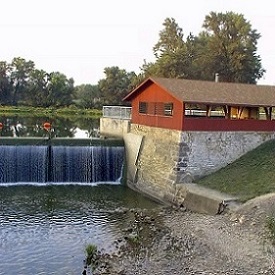The Long Arc of Flood Recovery: Fontana Park 1999
Fontana Park, Buchanan County
In a series of articles in The Otter Creek Quarterly, Harry Graves, the former director of the Buchanan County Conservation Board, tells the story of a destructive flood of Otter Creek at Fontana Park and the long process of recovery. It is a story familiar to many home, farm, or business owners, many residents, many insurance agents, many local government officials. Especially in Iowa, the state between the rivers with a lot of rivers in between, the increased frequency and severity of floods in recent decades make the story of “the flood” all too familiar.
Graves reports in the May 17, 1999, issue of The Otter Creek Quarterly that the May flood at Fontana Park and in northeast Iowa generally was the most severe to date. He quotes “old timers” saying that the flood records at the park from 1925, 1929, 1947, 1968, and 1990 “fell like grass before a scythe.” The destruction wrought to the park by the creek was beyond anything that had previously been witnessed and beyond anything that had been anticipated. At a depth of 12 feet the water cut a path around the shelter that had been built on the old mill dam. On the east side of the shelter the force of the water opened a gorge 30 feet wide, 200 feet long, and at a depth that descended to the bedrock 12 to 16 feet down. That same powerful flow cut a 6 x 12-foot hole in a 3-foot thick stone wall. Three miles away, neighbors could hear the roaring water. The campground was ruined and the park could not open on Memorial Day for the summer season as usual. In fact, it didn’t reopen for quite some time.
All this said, Graves is careful to note that as unprecedented as the park damage was its significance, of course, paled in comparison to the many homes lost elsewhere in northeast Iowa.
But this was not the end of the story. It was only the beginning. In the autumn, Graves explained in the newsletter that flood recovery at the park had been slowed by a deluge on July 3 and a second flood on July 21 that intensified erosion where streambanks had already been denuded of vegetation in May. And of course there were on-going negotiations about who would pay and for what? The cost share of the repair work was 75% the federal government through FEMA, 15% the local government, and 10% the state government. But this straightforward formula soon was complicated by the fact that FEMA would “repair the damage only to its predisaster condition” yet no repairs would mitigate future flooding if the two aging dams were not repaired first. Because their damage preceded the two recent floods, the cost of the dam repairs would have to be “borne solely by the Buchanan County Conservation Board.” Graves warned his readers that this would be a costly project in need of “public financial support on the local level.”
In the spring of 2000, Graves was writing again about the dam repairs, the need for local donors, and the plan, nonetheless, to begin repairs later that summer. A contractor had been secured. The summer issue informed readers, however, that the dam repairs had in fact not begun because a second bid on the project was required by law. When the autumn newsletter was published that second bid had been acquired and a contractor hired at a proposed cost of $249,000.00. Graves assured readers the conservation board was pursuing grants and loans but still was in need of donations.
By the winter Graves could write, with relief, that the flood repairs were nearing completion, and FEMA had approved $356,561 for total flood repairs, 75% of which they would pay. He told readers that though some doubted the process would end, “dogged determination” enabled the board to “prevail.” Graves’s praise for “dogged determination” was well earned, but “prevail” with its ring of finality may not have been quite the right word as the process of flood recovery—mitigation and adaptation as well as drying out and rebuilding—has continued in Fontana Park.
By spring of 2001, the new director, Dan Cohen, was still writing about the May 1999 flood, telling readers that fishing would finally return to Fontana Park soon following the removal of excess silt in the water. In the summer of 2002 Cohen wrote of properties in the county bought out by FEMA because they are in the flood plain, properties suitable for a park but not other kinds of development. In Autumn 2004, Cohen was writing again about a flood that had “wreaked havoc” on conservation lands in May of that year.

Sources: SHSI: The Otter Creek Quarterly, 1999-2004.
